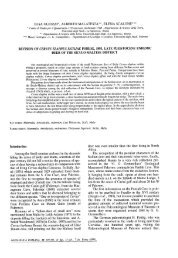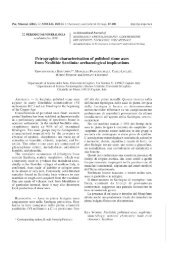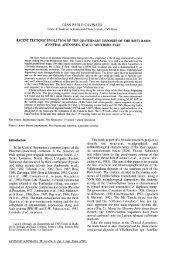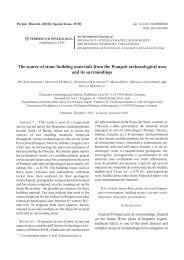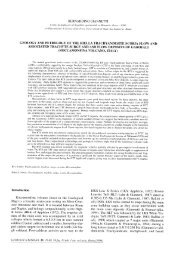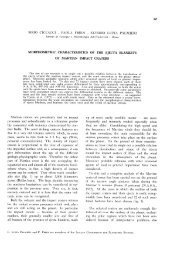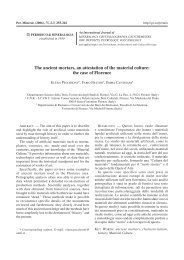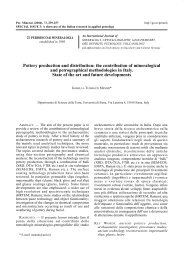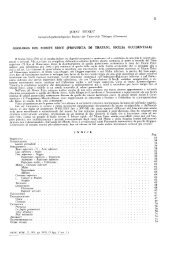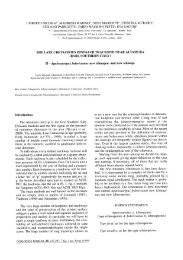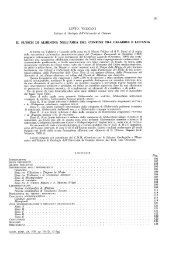PLIO-QUATERNARY MAMMAL FOSSILIFEROUS SITES OF UMBRIA
PLIO-QUATERNARY MAMMAL FOSSILIFEROUS SITES OF UMBRIA
PLIO-QUATERNARY MAMMAL FOSSILIFEROUS SITES OF UMBRIA
You also want an ePaper? Increase the reach of your titles
YUMPU automatically turns print PDFs into web optimized ePapers that Google loves.
INTRODUCTION<br />
The fossil mammalian fauna in Umbria is rich. The<br />
majority of the Plio-Pleistocene mammal faunas, discovered<br />
in Umbria, are represented by macromammals.<br />
These are more abundant because in the past only<br />
large animal remains were collected, as they are easier to<br />
discover and to recover them. Only large sized species of<br />
rodents (beaver, porcupine) and some lagomorphs were<br />
collected. However the fossil faunas of Umbria are<br />
represented by five orders of large mammals and four of<br />
micromammals. These fossil mammal remains represent<br />
all the orders and the majority of the families collected<br />
in the Pleistocene sites of Europe.<br />
Present day knowledge about terrestrial mammal faunas<br />
of the Plio-Pleistocene of Umbria does not allow<br />
attempting a detailed biochronology for the whole<br />
region. The chronological distribution of the mammalian<br />
fossiliferous layers is clear in the central and southern<br />
part of Umbria, because of the abundance of the fossils.<br />
In the northern part of the region there are instead<br />
many gaps due to the scarcity of fossiliferous beds. The<br />
distribution of the fossiliferous localities is referred to<br />
Faunal Unit (F.U.) successions and Mammal Ages following<br />
the biochronological scale of the continental succession<br />
in the Italian peninsula (Gliozzi et al., 1997). The<br />
fossil mammal remains found in Umbria are not uniformly<br />
distributed within the Plio-Pleistocene deposits, they<br />
are in fact concentrated in Late Pliocene and Early<br />
Pleistocene ones. Not all analysed localities are referred<br />
to a F.U. because in many sites only isolated fossils were<br />
discoveded or the fossils come from ancient collections,<br />
which are impossible to review; the localities are thus<br />
referred to Mammal Ages (Fig. 1). Some mammal assemblages<br />
are kept in cave deposits. In recent times two general<br />
works regarding some faunal assemblages of Umbria<br />
are published (Azzaroli, 2001; Petronio et al., 2003).<br />
The location of the fossiliferous sites is reported in Fig. 2.<br />
Geologica Romana 37 (2003-2004), 67-78<br />
<strong>PLIO</strong>-<strong>QUATERNARY</strong> <strong>MAMMAL</strong> <strong>FOSSILIFEROUS</strong> <strong>SITES</strong> <strong>OF</strong> <strong>UMBRIA</strong><br />
(CENTRAL ITALY)<br />
Patrizia Argenti<br />
Dipartimento di Scienze della Terra, Università degli studi di Perugia<br />
ABSTRACT - This work aims at providing the most complete catalogue of fossil mammal localities of Umbria,<br />
ranging from Pliocene to Holocene. The catalogue consists of fossil sites, known and reported since the XVIII century,<br />
in which faunal assemblages or even just single fossil remains were found. The catalogue allowed to<br />
biocronologically allocate the Plio-Pleistocene mammal assemblages of Umbria. The Pliocene assemblages are<br />
scarce, but the one found in Cava Toppetti (Todi) that was calibrated with paleomagnetic data is rather important.<br />
A very meaningful and rich fossil assemblage ascribable to the Plio-Pleistocene passage comes from Torre Picchio<br />
(Montecastrilli, Terni). Lower Pleistocene faunas are abundant and important since they are distributed on great<br />
part of the region’s territory. One example for all is the very rich collection from the Pietrafitta lignites. It is possible<br />
to ascribe, more or less in detail, such assemblages to the various Faunal Units. There are several Middle<br />
Pleistocene assemblages, but they are often not very rich. Upper Pleistocene faunas end Holocene faunas mostly<br />
come from Karst cavities.<br />
KEY WORDS: Fossiliferous sites, Mammals, Plio-Pleistocene, biochronology, Central Italy.<br />
EARLY VILLAFRANCHIAN ASSEMBLAGES<br />
(MIDDLE <strong>PLIO</strong>CENE)<br />
The only mammalian assemblage found in Umbria,<br />
referred to the Middle Pliocene was collected in the lignite<br />
mine of Spoleto. This can be referred to Triversa<br />
F.U. (early Villafranchian, Middle Pliocene) (Kotsakis,<br />
1986) for the presence of Mammut borsoni, Anancus<br />
arvernensis and Tapirus arvernensis. This assemblage is<br />
characteristic of the Early and Middle Pliocene<br />
(Ruscinian and Early Villafranchian). The beginning of<br />
Triversa F.U. should be around 3.2 M. years b.p. as suggested<br />
by paleomagnetic analysis at Fornace R.D.B.<br />
(Villafranca d’Asti, Piedmont) (Gliozzi et al., 1997).<br />
Some Mastodon arvernensis remains were found near<br />
Montoro (Tuccimei, 1891) and referred to Pliocene age.<br />
MIDDLE VILLAFRANCHIAN ASSEMBLAGES<br />
(LATE <strong>PLIO</strong>CENE)<br />
The assemblage of Cava Toppetti (Todi) is referred to<br />
Costa S. Giacomo F.U. (middle Villafranchian, Late<br />
Pliocene) (Abbazzi et al., 1997). The Apodemus dominans<br />
remains of Cava Toppetti are the same age as those<br />
found at Rivoli Veronese. Middle Villafranchian faunas<br />
are poorly represented in Italy.<br />
LATE VILLAFRANCHIAN ASSEMBLAGES<br />
(LATEST <strong>PLIO</strong>CENE AND EARLY<br />
PLEISTOCENE)<br />
The beginning of the late Villafranchian (Olivola F.U.)<br />
is marked by the appearance of Pachycrocuta brevirostris,<br />
Panthera gombaszoegensis and new species of<br />
Eucladoceros while dogs become widespread (Gliozzi et<br />
al., 1997). The mammal fossil assemblage collected in<br />
Pantalla (Todi) likely refers to the Olivola F.U. (late
68 Geologica Romana 37 (2003-2004), 67-78<br />
Fig. 1 - Biochronological distribution of the fossiliferous site of Umbria.<br />
Villafranchian, latest Pliocene) (Gentili et al., 1997): carnivors<br />
mainly characterize this assemblage.<br />
Torre Picchio is referred to the Olivola F.U. (or<br />
between the Olivola F.U. and Tasso F.U.) for stratigraphical<br />
correlation with marine strata, despite the presence<br />
of Mimomys medasensis, known from Late Pliocene of<br />
Ibero-occitan area. This arvicolid survives in Italian<br />
peninsula for longer time (Girotti et al., 2003).<br />
As regards the Parrano-Frattaguida fauna, this is quite<br />
heterogeneous and its stratigraphic position is unknown,<br />
it could be referred to the middle - late Villafranchian,<br />
ARGENTI<br />
after Ambrosetti (pers. com.) in this site is present<br />
Megantereon cultridens and Stephanorhinus etruscus<br />
(Verri, 1886; Clerici, 1896; Gliozzi et al., 1997).<br />
The assemblages found at Villa Spinola and Ponte<br />
S.Giovanni may be referred, very probably, to Tasso F.U.<br />
for their geographical and geological location (Argenti<br />
& Sardella, 2003). Fornace Ferrini-Ponte S.Giovanni<br />
remains are referred to the late Villafranchian for the<br />
correlation with the fauna of Villa Spinola and Piscille,<br />
which comes from the same levels (Argenti & Sardella,<br />
2003).
<strong>PLIO</strong>-<strong>QUATERNARY</strong> <strong>MAMMAL</strong> <strong>FOSSILIFEROUS</strong> ... Geologica Romana 37 (2003-2004), 67-78 69<br />
Fig. 2 - Distribution map of the fossiliferous sites: 1) Lignite mine of S. Croce (Spoleto); 2) Cava Toppetti (Todi); 3) Cava est Casigliano and Casale<br />
Violino (Casigliano, Acquasparta); 4) Fighille (Citerna); 5) Ellera of Corciano (now Filiale Lancia); 6) Casale Montecchio of Casalina (Deruta); 7)<br />
near S. Maria di Ciciliano (Montecastrilli); 8) near Orvieto; 9) Parrano - Frattaguida - S. Faustino; 10) Fontignano (Perugia); 11) Piscille (Perugia);<br />
12) Villa Spinola and near Ponte S. Giovanni (Perugia); 13) Some isolated localities in the neighbourhhods of Perugia (Colombella, Civitella d’Arno,<br />
S. Martino Delfico, Castel delle Forme, from S. Egidio to Deruta);14) Vigna Nuova (Piegaro); 15) Pietrafitta (Piegaro); 16) near Sanfatucchio<br />
(Vaiano); 17) Cava S. Faustino (Villa S. Faustino - Massa Martana); 18) Colle Pizzuto (Sangemini); 19) near Capitone (Narni); 20) near Colvalenza<br />
(Todi); 21) near Chioano (Todi); 22) Due Santi (Todi); 23) Colle Lame (Capitone, Narni); 24) M. Peglia (S. Venanzo); 25) Promano (Città di<br />
Castello); 26) near Marsciano; 27) near Lubriano (Corbara); 28) Poderetto (Pietrafitta); 29) M. Cucco cave; 30) Pozzo della Piana (Titignano); 31)<br />
Pantalla (Todi); 32) Civitella de’ Pazzi (Orvieto); 33) near Bettona; 34) Colle S. Andrea (S. Faustino); 35) Colle Violino (S. Faustino); 36) Casale le<br />
Grotte (S. Faustino); 37) near Pozzuolo (Trasimeno Lake); 38) near Montone (Umbertide); 39) near Paciano; 40) near Montefalco (Foligno); 41)<br />
near Montoro, Monte Campano lignite mine (Narni); 42) Rena between S. Fortunato e S. Martino in Colle (Perugia); 43) near M. Dell’Abbate<br />
between Perugia and Gubbio; 44) Railway tunnel of S. Costanzo (Perugia); 45) Fornace Ferrini, Ponte S. Giovanni (Perugia); 46) Torre Picchio<br />
(Montecastrilli); 47) near Gubbio (Scheggia); 48) Triponzo; 49) Taizzano (Narni); 50) Collelungo- Ravigliano, Tresa Valley; 51) Tane del Diavolo<br />
(Parrano); 52) S. Firmina- Fighille (Pistrino); 53) Colleluna (Terni).
70 Geologica Romana 37 (2003-2004), 67-78<br />
The Tasso F.U. is characterized by a change in faunal<br />
assemblage with the appearance of typical Quaternary<br />
elements such as Mimomys savini, Canis (Xenocyon)<br />
falconeri, Hippopotamus, Praeovibos and Leptobos vallisarni<br />
(Gliozzi et al., 1997). The fossils from S.Faustino,<br />
Cava est Casigliano, Colle Violino, Casale Le<br />
Grotte and Colle S. Andrea are referred to Tasso F.U.<br />
(Ambrosetti et al., 1995; Sardella et al., 1995).<br />
Vigna Nuova assemblage is probably referred to Tasso<br />
F.U., for its stratigraphic position with respect to<br />
Pietrafitta and its the paleontological assemblage (mainly<br />
for the presence of Megantereon cultridens). Fighille<br />
clays are referred to late Villafranchian, Tasso F.U. on<br />
the basis of mollusc assemblage (Gastrocopta<br />
(Vertigopsis) dehmi Schlimckum & Strauch, Multi-dentula<br />
helenae Esu and Parmacella (Parmacella) cf. P.<br />
(P.) sp.1 sensu Manganelli & Giusti) (Ciangherotti &<br />
Esu, 2000).<br />
Capitone must be probably referred to the end of the<br />
late Villafranchian because of the presence of Stephanorhinus<br />
etruscus, represented by an advanced form<br />
(Ambrosetti, 1972). This induces the formulation of a<br />
hypothesis regarding a stratigraphical correlation<br />
between Capitone and Torre Picchio the proof of which<br />
is left to further investigation. Anyway the Totte Picchio<br />
fauna is clearly older than the more advanced rhino<br />
found in Capitone.<br />
The Farneta F.U. is characterized by a new situation:<br />
Leptobos and Eucladoceros are still present, while the<br />
Megaceroides clade (M. obscurus) and the voles<br />
Microtus (Allophaiomys) chalinei and M. (A.) cf. M. (A.)<br />
ruffoi appear (Gliozzi et al., 1997). Ellera remains are<br />
referred to the Farneta F.U. for the mammal assemblage<br />
(Ambrosetti et al., 1994). The mammal assemblage from<br />
Pietrafitta is referred to the Farneta F.U. and it is typical<br />
of this faunal unit with Megaceroides obscurus, the<br />
voles of subgenus Microtus (Allophaiomys) and<br />
Mimomys pusillus. The faunal remains of Sanfatucchio<br />
and S. Maria di Ciciliano are referred to the late<br />
Villafranchian, probably the upper part, because they<br />
were collected in the upper part of the S. Maria di<br />
Ciciliano Formation. Casalina sands are referred to the<br />
latest Villafranchian because Mammuthus meridionalis<br />
collected in this locality belongs to an advanced form.<br />
The mammal remains from Fontignano are referred to<br />
the upper part of late Villafranchian, for the advanced<br />
form of hippo recorded (Kotsakis, 1992).<br />
GALERIAN ASSEMBLAGES (LATEST EARLY<br />
PLEISTOCENE AND MIDDLE PLEISTOCENE)<br />
The Colle Curti F.U. is characterized by the appareance<br />
of voles such as Microtus (Allophaiomys) nutiensis and<br />
Microtus (Allophaiomys) burgondiae, Pliomys lenki and<br />
the first form of Megaceroides verticornis. The mammal<br />
assemblages found in the M. Peglia cave are referred to<br />
the Colle Curti F.U. (Meulen, 1973; Gliozzi et al., 1997),<br />
for the presence of Microtus (Allophaiomys) nutiensis<br />
ARGENTI<br />
and Microtus (Allophaiomys) burgondiae. The mammal<br />
remains found in the sands of Promano (Città di Castello)<br />
(lower assemblage) are referred to the lower part of the<br />
early Galerian, probably Colle Curti F.U., mainly for the<br />
presence of Mega-ceroides verticornis and an advanced<br />
form of Mammuthus meridionalis (Argenti et al., in<br />
prep.). The fossil remains found near Marsciano are<br />
referred to the early Galerian for the presence of a cervid<br />
classified as Megaceroides cfr. M. verticornis. The elephant<br />
of Fighille is probably referred to early Galerian<br />
unfortunatly the sediments where it was recorded do not<br />
exist anymore. The elephant’s site is on the Tiber terrace<br />
that covers the clay quarry. Another assemblage was<br />
found in Promano sands, referred to middle Galerian, but<br />
after Colle Curti F.U., for the presence of Stephanorhinus<br />
hemitoechus (Argenti et al., in prep.).<br />
AURELIAN ASSEMBLAGES (LATE MIDDLE<br />
PLEISTOCENE AND LATE PLEISTOCENE)<br />
A marked faunistic renewal occurs at the beginning of<br />
the Aurelian, with the extinction of some Galerian forms<br />
such as the archaic megacerine cervids, the more archaic<br />
elaphine deer and the arrival of Canis lupus and Ursus<br />
spelaeus. The sands overlapping Poderetto lignites are<br />
referred to the middle Aurelian for their radiometric age<br />
(160-170.000 years b.p., Ambrosetti, pers. comm.).<br />
During late Aurelian Dama dama (modern form)<br />
appeared, Capra ibex, Coelodonta antiquitatis, Mammuthus<br />
primigenius, Marmota marmota spread over<br />
Italy and several taxa of large herbivores and carnivores<br />
progressively disappeared in correspondance with the<br />
successive phases of climatic deterioration. The mammal<br />
assemblage from the M. Cucco cave is referred to<br />
late Aurelian, for the presence of Dama dama, Capra<br />
ibex, Coelodonta antiquitatis. The assemblage from<br />
Tane del Diavolo is referred to Aurelian, for the presence<br />
of Equus ferus, probably for the presence of abundant<br />
archeological remains of upper Paleolithic (Calzoni,<br />
1956).<br />
The assemblage from Pozzo della Piana is referred to<br />
the cool or cold phase of late Aurelian for the presence<br />
of Capra ibex.<br />
HOLOCENE DEPOSITS<br />
For the third mammal assemblage of Promano an attribution<br />
to the late Aurelian or to Holocene is uncertain<br />
whilst the mammal assemblage found at Triponzo<br />
belongs clearly to Holocene.<br />
ACKNOWLEDGEMENTS - Many sincere thanks to Prof.<br />
T. Kotsakis, Prof. P. Ambrosetti and Prof. O. Girotti for the<br />
critical revision of manuscript. I am indebted to Dott.ssa M.C.<br />
De Angelis, Soprintendenza Archeologica dell’Umbria and<br />
Prof. C. Giovagnotti, Istituto di Pedologia agraria, Università<br />
degli Studi of Perugia.<br />
Many thanks also to Mrs. H. Terry and Dott.ssa N. Minciotti<br />
for the revision of the english manuscript.
<strong>PLIO</strong>-<strong>QUATERNARY</strong> <strong>MAMMAL</strong> <strong>FOSSILIFEROUS</strong> ... Geologica Romana 37 (2003-2004), 67-78 71<br />
Abbazzi L. (1996) - Variazioni nei popolamenti di cervidi<br />
durante il Pleistocene italiano. 399 p., Ph. D. Thesis,<br />
Consorzio Universitario Modena, Bologna, Firenze e<br />
Roma “La Sapienza”.<br />
Abbazzi L., Albianelli A., Ambrosetti P., Argenti P., Basilici G.,<br />
Gentili S. Masini, F. & Pontini M.R. (1997) - Palaeontological<br />
and sedimentological records in Pliocene distal<br />
alluvial fan deposit (Cava Toppetti near Todi, Central<br />
Italy). Boll. Soc. Paleont. Ital., 36, 5-22.<br />
Ambrosetti P. (1972) - Lo scheletro di Dicerorhinus etruscus<br />
(Falc.) di Capitone (Umbria meridionale). Geologica Romana,<br />
11, 177-198.<br />
Ambrosetti P., Argenti P., Basilici G., Gentili S. & Ikome F.E.<br />
(1992a) - The fossil vertebrates of the Pietrafitta basin<br />
(Perugia, Umbria, Italy): preliminary analysis of the<br />
processes responsable for “paleontological production”.<br />
Res. EPA Workshop, “Taphonomy: processes and<br />
products”, Strasbourg, 26/27 Luglio 1992, 20-21.<br />
Ambrosetti P., Basilici G., Capasso Barbato L., Carboni<br />
M.G., Di Stefano G., Esu D., Gliozzi E., Petronio C.,<br />
Sardella R. & Squazzini E. (1995) - Il Pleistocene inferiore<br />
nel ramo sud-occidentale del Bacino Tiberino<br />
(Umbria): aspetti litostratigrafici e biostratigrafici. Il<br />
Quaternario, 8, 16-36.<br />
Ambrosetti P., Carboni M.G., Conti M.A., Esu D., Girotti O.,<br />
La Monica G.B., Landini B., Parisi G. (1987a) - Il Pliocene<br />
ed il Pleistocene inferiore del bacino del fiume Tevere<br />
nell’Umbria meridionale. Geogr. Fis. Dinam. Quat., 10,<br />
10-33.<br />
Ambrosetti P., Capurso R., Cavina R., Gallo G., Monicchia R.<br />
& Salvatici B. (1992b) - Storia, Energia, Ambiente: un<br />
modello di centrale a Pietrafitta. 114 p., Protagon Editore,<br />
Perugia.<br />
Ambrosetti P., Faraone A. & Gregori L. (1987b) - Pietrafitta:<br />
un museo di paleontologia in Umbria. Museol. Scient., 4,<br />
99-118.<br />
Ambrosetti P., Venturi F., Basilici G., Gentili S., Andreoni C.,<br />
De Angelis M.C. & Moroni Lanfredini A. (1994) -<br />
Corciano: materiali preistorici e paleontologici. 64 p.,<br />
Quattroemme Editore, Perugia.<br />
Ambrosetti P. , Conti M.A., Parisi G., Kotsakis T. & Nicosia U.<br />
(1979) - Neotettonica e cicli sedimentari plio-pleistocenici<br />
nei dintorni di Città della Pieve (Umbria). Boll. Soc. Geol.<br />
Ital., 96 (1977), 606-635.<br />
Argenti P. (1990) - Il giacimento Pleistocenico di Pietrafitta<br />
(PG): dati paleobiologici. 71 p., Tesi di Laurea, Università<br />
degli Studi di Perugia.<br />
Argenti P. (1999) - La biocronologia dei roditori del Plio-<br />
Pleistocene dell’Umbria e l’evoluzione del genere Apodemus<br />
in Italia. 240 p., Ph. D. Thesis, Università degli<br />
Studi di Perugia, Perugia.<br />
Argenti P., Abbazzi L., Ambrosetti P., Kotsakis T., Ferretti<br />
M.P., Masini F., Mazza P., Rustioni M. & Sardella R. (in<br />
prep.) - The Quaternary mammal faunas of Citta’ di<br />
Castello (North Tiberino Basin, Umbria, Central Italy).<br />
Argenti P. & Kotsakis T. (in prep.) - The fossil remains of<br />
Lagomorpha and Soricidae (Mammalia,) in the late<br />
Villafranchian of Pietrafitta (Perugia, Central Italy).<br />
Argenti P. & Sardella R. (2003) - Large mammals biochronology<br />
of the Early Pleistocene fauna from Villa Spinola<br />
(Perugia, Central Italy): a revision of Panthera gombaszoegensis<br />
Kretzoi remains. Boll. Soc. Pal. Ital., 42.<br />
REFERENCES<br />
Azzaroli A. (2001) - Middle and Late Villafranchian<br />
Vertebrates from Tuscany and Umbria. A synopsis. Boll.<br />
Soc. Paleont. It., 40, 351-356.<br />
Azzaroli A. & Mazza P. (1993) - Large Early Pleistocene deer<br />
from Pietrafitta lignite mine, Central Italy. Palaeontographia<br />
Ital., 80, 1-24.<br />
Barisone G., Argenti P. & Kotsakis T. (in press) - The genus<br />
Castor (Mammalia, Rodentia) in the Late Villafranchian of<br />
Pietrafitta (Perugia, Central Italy). Riv. Ital. Paleont. Strat.<br />
Bartolini R. (1975) - La fauna a mammiferi villafranchiani di<br />
Città di Castello: cane, orso, iena, Sus, castoro. 162 p., Tesi<br />
di Laurea, Università degli Studi di Perugia,.<br />
Bartolomei G. (1969) - Rinvenimento di resti di elefante presso<br />
Citerna (Perugia). Ann. Univ. Ferrara, n.s., sez. 9, 4,<br />
267-274.<br />
Basilici G. (1992) - Il bacino continentale tiberino (Plio-<br />
Pleistocene, Umbria): analisi sedimentologica e stratigrafica.<br />
323 p., Ph. D. Thesis, Università degli Studi di<br />
Bologna, Bologna.<br />
Basilici G., Faraone A.G. & Gentili S. (1991) - Un nuovo<br />
reperto di Macaca nelle breccie ossifere pleistoceniche di<br />
Monte Peglia (Terni, Italia Centrale). Boll. Soc. Paleont.<br />
Ital., 30, 251-254.<br />
Bertoldi R. (1988) - Una sequenza palinologica di età rusciniana<br />
nei sedimenti lacustri basali del bacino di Aulla-Olivola<br />
(Val di Magra). Riv. Ital. Paleont. Strat., 94, 105-138.<br />
Blanc A.C. (1955) - Breccia ossifera villafranchiana a Monte<br />
Peglia (Orvieto). Quaternaria, 2, 314-317.<br />
Bonarelli G. (1891) - Il territorio di Gubbio. Notizie geologiche.<br />
38 p., Roma.<br />
Bortolotti C. (1903) - Intorno ad alcuni resti di rinoceronte nei<br />
dintorni di Perugia. Riv. Ital. Paleont., 9, 50-53.<br />
Bortolotti C. (1904) - Denti di proboscidati, di rinoceronte di<br />
ippopotamo dell’antica collezioni Canali di Perugia. Riv.<br />
Ital. Paleont., 10, 83-93.<br />
Bortolotti C. (1905) - Intorno ad un resto di mandibola di iena.<br />
Riv. Ital. Paleont., 11, 34-36, Bologna.<br />
Calzoni U. (1956) - Il Museo preistorico dell’Italia centrale<br />
“Giuseppe Bellucci”. 74 p., Istituto Poligrafico dello Stato,<br />
Roma.<br />
Capasso Barbato L., Cuggiani M.C. & Petronio C. (1985) - I<br />
macromammiferi del Pleistocene superiore della Grotta di<br />
Monte Cucco (Sigillo-Perugia). Boll. Serv. Geol. Ital., 53,<br />
105-131.<br />
Capasso Barbato L. & Kotsakis T. (1986) - Les chiroptères du<br />
Pléistocène superieur de la Grotte de Monte Cucco (Italie<br />
centrale). Geol. Romana, 25, 309-316.<br />
Capellini G. (1888) - Sui resti di Mastodon arvernensis recentementi<br />
scoperti a Spoleto, Pontremoli e Castrocaro. Mem.<br />
R. Accad. Sci. Bologna, s. 4, 9, 251-258.<br />
Capellini G. (1889) - Sulla scoperta di una caverna ossifera a<br />
Monte Cucco. Boll. Soc. Geol. Ital., 8, 274-278, Roma.<br />
Capellini G. (1890) - Comunicazione sui vertebrati fossili rinvenuti<br />
nella grotta di Monte Cucco presso Fabriano. Boll.<br />
Soc. Geol. Ital., 9, 743-744.<br />
Ciangherotti A. & Esu D. (2000) - Paleoecologic and<br />
biochronologic meaning of the Early Pleistocene molluscan<br />
fauna from Anghiari basin (Tiber River Upper Valley,<br />
central Italy). Boll. Soc. Paleont. Ital., 39, 217-224.<br />
Clerici E. (1894) - Sul ritrovamento del castoro nelle ligniti di<br />
Spoleto. Boll. Soc. Geol. Ital., 13, 169, 199-202.<br />
Clerici E. (1895) - Ritrovamento di resti di tapiro nelle ligniti
72 Geologica Romana 37 (2003-2004), 67-78<br />
di Spoleto. Boll. Soc. Geol. Ital., 14, 296-297.<br />
Clerici E. (1896) - Sui dintorni di S. Faustino nell’Umbria.<br />
Boll. Soc. Geol. Ital., 15, 426-429.<br />
Conti M.A. & Esu D. (1981) - Considerazioni sul significato<br />
plaeoclimatico e geodinamico di una serie lacustre pleistocenica<br />
inferiore presso Tavernelle (Perugia, Umbria).<br />
Geogr. Fis. Dinam. Quat., 4, 3-10.<br />
Cuvier G. (1834) - Le ossaments fossiles. Paris. Fide Bonarelli,<br />
198.1<br />
De Angelis d’Ossat G. (1918) - Rinvenimento di mammiferi<br />
fossili nel Pliocene lacustre e salmastro umbro. Boll. Soc.<br />
Geol. Ital., 37, 39-45.<br />
Delfino M. (2002) - Erpetofaune italiane del Neogene e del<br />
Quaternario. 382 p., Ph. D. Thesis, Consozio Universitario<br />
Modena, Bologna, Firenze e Roma “La Sapienza”,<br />
Modena.<br />
Esu D. & Girotti O. (1991) - Late Pliocene and Pleistocene<br />
assemblages of continental molluscs in Italy. A survey. Il<br />
Quaternario, 4, 137-150.<br />
GEMINA (1963) - Ligniti e torbe dell’Italia continentale:<br />
indagini geominerarie effettuate nel periodo 1958-1961.<br />
319 p., Roma.<br />
Gentili S. (1985) - Gli elefanti pleistocenici dell’Italia centrale:<br />
morfologia dell’astragalo. 118 p., Tesi di Laurea, Università<br />
degli Studi di Perugia.<br />
Gentili S. (1991) - Studio dei caratteri tafonomici nelle associazioni<br />
a Vertebrati dei depositi Plio-Pleistocenici umbri:<br />
il Bacino di Pietrafitta. 37 p., Relazione Borsa di Studio in<br />
“Sedimentologia e stratigrafia delle formazioni plio-pleistoceniche”,<br />
CNR, Roma.<br />
Gentili S., Abbazzi L., Masini F., Ambrosetti P., Argenti P. &<br />
Torre D. (1996) - Voles from the Early Pleistocene of<br />
Pietrafitta (Central Italy, Perugia). Acta Zool. Cracov, 39,<br />
185-199.<br />
Gentili S., Ambrosetti P. & Argenti P. (1997a) - Large carnivore<br />
and other mammal fossils from the early alluvial plain of<br />
the Tiberino Basin (Pantalla, Central Italy). Preliminary<br />
reports. Boll. Soc. Paleont. Ital., 36, 233-240.<br />
Gentili S,. Barili A. & Ambrosetti P. (1999) - Lignites, fossils<br />
and miners! A paleontological heritage at Pietrafitta<br />
(Perugia, Central Italy). Fist Geoitalia 1999, Riassunti, 47-<br />
49, Bellaria.<br />
Gentili S., Mottura A. & Rook L. (1997b) - The Italian fossil<br />
primate record: recent finds and their geological context.<br />
Geobios, 31, 675-686.<br />
Girotti O., Capasso Barbato L., Esu D., Gliozzi E., Kotsakis T.,<br />
Martinetto E., Petronio C., Sardella R. & Squazzini E.<br />
(2003) - The section of Torre di Picchio (Terni, Umbria,<br />
central Italy): a Villafranchian site rich in vertebrates, molluscs,<br />
ostracods and plants. Riv. Ital. Paleont. Strat., 109,<br />
77-98.<br />
Gliozzi E., Abbazzi L., Argenti P., Azzaroli A., Caloi L.,<br />
Capasso Barbato L., Di Stefano G., Esu D., Ficcarelli G.,<br />
Girotti O., Kotsakis T., Masini F., Mazza P., Mezzabotta<br />
C., Palombo M.R., Petronio C., Rook L., Sala B., Sardella<br />
R., Zanalda E. & Torre D. (1997) - Biochronology of<br />
selected mammals, molluscs and ostracods from Middle<br />
Pliocene to the Late Pleistocene in Italy. The state of art.<br />
Riv. Ital. Paleont. Strat., 103, 369-388.<br />
Ikome F.E. (1995) - Un contributo alla ricostruzione della filogenesi<br />
delle forme elefantine europee, mediante modellamento<br />
matematico della biometria dentaria. 97 p., Ph. D.<br />
Thesis, Università degli Studi di Perugia.<br />
IRRES (1990) - Unità di paesaggio della provincia di Terni.<br />
ARGENTI<br />
286 p., Perugia.<br />
Kotsakis T. (1986) - Elementi di paleobiogeografia dei mammiferi<br />
terziari dell’Italia. Hystix,1, 25-68.<br />
Kotsakis T. (1992) - Giacimenti di Vertebrati fossili nell’area<br />
della media Valle del Tevere. Guide Book, 5° Simp. Ecol.<br />
Paleoecol. comunità bentoniche, 11-13, Roma.<br />
Kotsakis T. & Gregori L. (1985) - I resti di Emys orbicularis<br />
(Linnaeus) (Emydidae, Testudinata) del Pleistocene inferiore<br />
di Pietrafitta (Perugia, Italia centrale). Geologica<br />
Romana, 24, 1-12.<br />
Lippi Boncampi C. (1963) - Su di un ritrovamento di resti fossili<br />
di Elephas nell’Alta Valtiberina. Mem. Rassegna<br />
Speleol. It., 7, 1-3, (reprint).<br />
Mazza P., Sala B. & Fortelius M. (1993) - A small Latest<br />
Villafranchian (late Early Pleistocene) rhinoceros from<br />
Pietrafitta (Perugia, Umbria, Central Italy), with notes on<br />
the Pirro and Westerhoven rhinoceros. Palaeontographia<br />
Ital., 80, 25-50.<br />
Meli R. (1895) - Notizie sui resti di Mammiferi fossili rinvenuti<br />
in località italiane. Boll. Soc. Geol. Ital., 14, 148-164.<br />
Meulen van der A.J. (1973) - Middle Pleistocene smaller mammals<br />
from the Monte Peglia, (Orvieto, Italy) with special<br />
reference to the phylogeny of Microtus (Arvicolidae,<br />
Rodentia). Quaternaria, 17, 1-143.<br />
Moretti A. (1947-48-49) - Resti di “Elephas meridionalis”<br />
Nesti nelle ligniti di Pietrafitta (bacino Tiberino). Boll.<br />
Serv. Geol. Ital., 71, 51-57.<br />
Paganelli A. (1960) - Primi saggi per uno studio pollinologico<br />
del deposito lignitifero di Pietrafitta (Umbria). N. Giorn.<br />
Bot. Ital., 67, 601-605.<br />
Petronio C., Argenti P., Caloi C., Esu D., Girotti O. & Sardella<br />
R. (2003) - Updating Villafranchian mollusc and mammal<br />
faunas in Umbria and Latium (Central Italy). Geologica<br />
Romana, 36, 369-387.<br />
Piperno M., Segre A. G. & Segre Naldini E. (1985) - Monte<br />
Peglia (Umbria). In “I primi Abitanti d’Europa”, 115-119.<br />
Principi P. (1922) - Alcune osservazioni sul Quaternario dell’Umbria<br />
centrale. Atti R. Acc. Naz. Lincei, s. 5, 31, 56-59.<br />
Principi P. (1930) - Alcune osservazioni intorno all’età dei<br />
travertini di Ellera nei dintorni di Perugia. Atti R. Acc. Naz.<br />
Lincei, s. 6, 11, 493-495.<br />
Rabeder G. (1981) - Die Arvicoliden (Rodentia, Mammalia)<br />
aus dem Pliozän und dem älteren Pleistozän von<br />
Niederösterreich. Beitr. Paläont. Österr., 8, 1-373.<br />
Ramaccioni G. (1936) - Scheletro di ippopotamo rinvenuto nel<br />
Villafranchiano dei dintorni di Perugia. Atti Soc. Tosc. Sc.<br />
Nat. P. V., 45, 31-34.<br />
Rook L. (1995) - Pannonictis nestii (Carnivora, Mammalia)<br />
from the late Villafranchian of Pietrafitta (Umbria, Italy).<br />
Preliminary note. Eclogae Geol. Helv., 88, 853-864.<br />
Rustioni M. & Mazza P. (1993) - The Late Villafranchian bear<br />
from Pietrafitta (Perugia, Central Italy). Palaeontographia<br />
Ital., 80, 51-62.<br />
Sardella R., Di Stefano G. & Petronio C. (1995) - The<br />
Villafranchian mammal faunas from the Tiber River Basin<br />
(Umbria, Central Italy). Il Quaternario, 8, 509-514.<br />
Simonelli V. (1917) - I mammiferi fossili della Caverna di<br />
Monte Cucco. Mem. R. Acc. Sc. Ist. Bologna, s. 7, 3 (1915-<br />
1916), 272-284.<br />
Taliana D., Alessio M., Allegri M., Capasso Barbato L., De<br />
Angelis C., Esu D., Girotti O., Gliozzi E., Improta S.,<br />
Mazzini I. & Sardella R. (1996) - Preliminary results on the<br />
“Grotta del Lago” Holocene deposits (Triponzo, Nera<br />
River Valley, Umbria, Central Italy). Il Quaternario, 9,
<strong>PLIO</strong>-<strong>QUATERNARY</strong> <strong>MAMMAL</strong> <strong>FOSSILIFEROUS</strong> ... Geologica Romana 37 (2003-2004), 67-78 73<br />
745-752.<br />
Tuccimei G. (1891) - Sui mammiferi fossili dell’Umbria e<br />
della provincia di Roma. Atti Acc. Pont. Nuovi Lincei, 44,<br />
274-275.<br />
Tuccimei G. (1895) - Sopra i resti fossili di mammiferi trovati<br />
alla Villa Spinola presso Perugia. Atti Acc. Pont. Nuovi<br />
Lincei, 48, 44-46.<br />
Tuccimei G. (1896) - Resti di Felis arvernensis nel Pliocene<br />
della Villa Spinola presso Perugia. Mem. Acc. Pont. Nuovi<br />
Lincei, 12, 1-27.<br />
Ugolini R. (1921) - Sopra alcuni resti di rinoceronte del<br />
Pliocene lacustre di Pietrafitta in Provincia di Perugia. Riv.<br />
Ital. Paleont., 27, 15-18.<br />
Verri A. (1886) - Azione delle forze nell’assetto delle valli con<br />
appendice sulla distribuzione dei fossili nella Valdichiana e<br />
nell’Umbria interna settentrionale. Boll. Soc. Geol. Ital., 5,<br />
416-454.<br />
Accettato per la stampa: Marzo 2003
74 Geologica Romana 37 (2003-2004), 67-78<br />
In the following list the number in haevy type is referred to the<br />
number of the site in the map.<br />
Locality: Montoro, lacustrine clay (41).<br />
Mammal assemblage: Anancus arvernensis (Croizet & Jobert)<br />
Age: Pliocene.<br />
Collection: University Museum of “La Sapienza”, Roma.<br />
References: Tuccimei, 1891.<br />
Locality: lignite mine of S. Croce (Spoleto) (1).<br />
Mammal assemblage: Mammut borsoni (Hays), Anancus<br />
arvernensis, Tapirus arvernensis Croizet & Jobert, Cervidae<br />
indet., Castor sp.<br />
Age: Triversa F.U.<br />
Collection: Toni Collection now preserved in the Liceo<br />
Scientifico of Spoleto (Perugia).<br />
References: Capellini, 1888; Clerici, 1894, 1895, 1896; Meli,<br />
1895; GE.MI.NA., 1963; Kotsakis, 1986.<br />
Locality: Cava Toppetti (Todi) (2), Ponte Naia Formation.<br />
Mammal assemblage: Stephanorhinus cf. S. etruscus<br />
(Falconer), Pseudodama cf. P. rhenana (Dubois), Procapreolus<br />
sp., Leptobos sp., Apodemus dominans Kretzoi.<br />
Age: Costa S. Giacomo F.U.<br />
Collection: Dipartimento di Scienze della Terra, Università<br />
degli Studi of Perugia.<br />
References: Ambrosetti et al. 1987a; Basilici, 1992; Abbazzi et<br />
al., 1997; Argenti, 1999.<br />
Locality: Pantalla (Todi) (31) in the S. Maria di Ciciliano<br />
Formation.<br />
Mammal assemblage: Lynx cf. L. issiodorensis (Croizet &<br />
Jobert), Panthera cf. P. gombaszoegensis (Kretzoi), Canis etruscus<br />
Major, Equus sp., Sus cf. S. strozzii Meneghini, Pseudodama<br />
cf. P. nestii (Major), Leptobos sp., Apodemus dominans,<br />
Aves.<br />
Age: probably Olivola F.U.<br />
Collection: Dipartimento di Scienze della Terra, Università<br />
degli Studi of Perugia.<br />
References: Gentili et al., 1997a.<br />
Locality: Torre Picchio (Montecastrilli, TR) (46), in the S.<br />
Maria di Ciciliano Formation.<br />
Mammal assemblage: Canis cf. C. arnensis Del Campana,<br />
?Baranogale sp., ?Homotherium crenatidens Fabrini,<br />
Mammuthus meridionalis (Nesti), Equus cf. E. stenonis Cocchi,<br />
Stephanorhinus cf. S. etruscus, Sus strozzii, Eucladoceros<br />
dicranios (Nesti) vel ctenoides (Nesti), Axis nestii (Major),<br />
Cervidae gen. et sp. indet., Leptobos cf. L. etruscus (Falconer),<br />
Bovidae gen. et sp. indet. (medium size antilope), Bovidae gen.<br />
et sp. indet., Mimomys medasensis Michaux, Prolagus sp.,<br />
Oryctolagus cf. O. lacosti (Pomel).<br />
Age: probably Olivola F.U.<br />
Collection: Soprintendenza per i Beni Archeologici of Umbria.<br />
References: Argenti, 1999; Girotti et al., 2003.<br />
Locality: Cava est Casigliano and Casale Violino (Casigliano,<br />
Acquasparta), (3), S. Maria di Ciciliano Formation.<br />
Mammal assemblage: Pachycrocuta brevirostris (Aymard),<br />
Rhinocerotidae indet., Pseudodama sp., Castor sp.<br />
Age: Tasso F.U.<br />
Collection: ex-church of S. Tommaso of Terni.<br />
References: Basilici, 1992; Ambrosetti et al., 1995.<br />
APPENDIX<br />
ARGENTI<br />
Locality: clay quarry of Fighille (Citerna) (4).<br />
Mammal assemblage: Leptobos cf. L. vallisarni Merla and<br />
incisors of rodents.<br />
Age: Tasso F.U.<br />
Collection: Dipartimento di Scienze della Terra, Università<br />
degli Studi of Perugia.<br />
References: Gentili & Masini (pers. comm.); Argenti, 1999.<br />
Locality: Vigna Nuova (Piegaro) (14).<br />
Mammal assemblage: Megantereon cultridens (Cuvier), Equus<br />
sp., Rhinocerotidae indet., Sus sp., Cervidae indet. (a big form<br />
and a very small one), Bovidae indet.<br />
Age: probably Tasso F.U.<br />
Collection: Dipartimento di Scienze della Terra, Università<br />
degli Studi of Perugia.<br />
References: this paper.<br />
Locality: Cava S. Faustino (Villa S. Faustino - Massa Martana)<br />
(17).<br />
Mammal assemblage: Megantereon cultridens, Mammuthus<br />
meridionalis, Equus stenonis, Pseudodama nesti s.l, Eucladoceros<br />
sp.<br />
Age: Tasso F. U.<br />
Collection: Soprintendenza per i Beni Archeologici of Umbria.<br />
References: Ambrosetti et al., 1995; Sardella et al., 1995.<br />
Locality: Colle S. Andrea (S. Faustino) (34).<br />
Mammal assemblage: Pachycrocuta cf. P. brevirostris,<br />
Cervidae indet., Leptobos cf. L. vallisarni, Castor sp.<br />
Age: Tasso F.U.<br />
Collection: Soprintendenza per i Beni Archeologici of Umbria.<br />
References: Ambrosetti et al., 1995; Sardella et al., 1995.<br />
Locality: Colle Violino (S. Faustino) (35).<br />
Mammal assemblage: Stephanorhinus etruscus.<br />
Age: Tasso F. U.<br />
Collection: Soprintendenza per i Beni Archeologici of Umbria.<br />
References: Ambrosetti et al., 1995; Sardella et al., 1995.<br />
Locality: Casale le Grotte (S. Faustino) (36).<br />
Mammal assemblage: Eucladoceros sp.<br />
Age: Tasso F. U.<br />
Collection: Soprintendenza per i Beni Archeologici of Umbria.<br />
References: Ambrosetti et al., 1995; Sardella et al., 1995.<br />
Locality: Ellera of Corciano (now Filiale Lancia of Ellera) (5).<br />
Mammal assemblage: remains referred to “Elephas antiquus<br />
Falconer & Cautley, Cervus elaphus Linnaeus, Bos primigenius<br />
Bojanus, Sus scrofa Linnaeus, Ursus spelaeus<br />
Rosenmüller & Heinroth” and other rests of bovids were collected<br />
in the past and now probably destroyed.<br />
In the collection are preserved: cf. Panthera gombaszoegensis,<br />
Stephanorhinus cf. S. etruscus, Hippopotamus cf. H. antiquus<br />
Desmarest, cf. Eucladoceros sp. (senezensis type, big form),<br />
Pseudodama sp., Leptobos cf. L. vallisarni (big form, enough<br />
evolved).<br />
Age: Farneta F. U.<br />
Collection: Museum of Corciano.<br />
References: Principi, 1930; Ambrosetti et al., 1994.<br />
Locality: Pietrafitta (Piegaro) (15), in the lignite.<br />
Mammal assemblage (and other fossil remains): Sorex sp.,<br />
(size S. minutus Linnaeus), Macaca sylvana florentina Cocchi,
<strong>PLIO</strong>-<strong>QUATERNARY</strong> <strong>MAMMAL</strong> <strong>FOSSILIFEROUS</strong> ... Geologica Romana 37 (2003-2004), 67-78<br />
75<br />
Panthera gombaszoegensis, Pannonictis nestii (Martelli),<br />
Ursus etruscus Cuvier, Mammuthus meridionalis vestinus<br />
Azzaroli, Equus sp., Stephanorhinus cf. S. hundsheimensis<br />
(Toula), Megaceroides obscurus Azzaroli (= M. boldrinii<br />
Azzaroli), Pseudodama farnetensis Azzaroli, Leptobos aff. L.<br />
vallisarni, Castor fiber Linnaeus, Mimomys pusillus Mèheley,<br />
Microtus (Allophaiomys) cf. M. (A.) ruffoi (Pasa), M. (A.) chalinei<br />
Alcade, Agustì & Villalta, Oryctolagus cf. O. lacosti.<br />
Abundant fossil remains were also found of: birds (Anatidae,<br />
Ardeidae, Podicipedidae and Tetraonidae), reptiles (Emys<br />
orbicularis (Linnaeus), Natrix sp., Vipera ammodytes<br />
(Linnaeus)) and amphibians (Latonia cf. L. ragei Hossini,<br />
Rana gr. R. ridibunda Pallas). The numerous fish remains have<br />
not yet been studied. In the lignite some levels bearing a rich<br />
molluscan fauna have still not been studied in detail: Ancylus<br />
sp., Bithynia tentaculata, Lymnaea bucciniformis, Unio sp..<br />
Finally the macrofloristic fossil remains (leaves, seeds, fruits<br />
and stems) and the pollens are referred to: Pinus, Tsuga,<br />
Quercus, Pterocarya, Carya, Zelkova, Liquidambar.<br />
Age: Farneta F.U.<br />
Collection: the Thermoelectric Station “Città di Roma” of<br />
Pietrafitta of ENEL (the Italian National Electricity Company)<br />
of Pietrafitta and in the Boldrini Collection (Pietrafitta).<br />
References: Ugolini, 1921; Moretti, 1947-49; Ambrosetti et al.,<br />
1987b; Ambrosetti et al., 1992a, Ambrosetti et al., 1992b;<br />
Argenti, 1990; Gentili, 1991; Azzaroli & Mazza, 1993; Mazza<br />
et al., 1993; Rustioni & Mazza, 1993; Rook, 1995; Ikome,<br />
1995; Abbazzi, 1996; Gentili et al., 1996; Gentili et al., 1997b;<br />
Argenti 1999; Gentili et al., 1999; Barisone et al., (in press),<br />
Argenti & Kotsakis (in prep.) for mammals. Kotsakis &<br />
Gregori, 1985; Delfino, 2002 for reptiles and amphibians.<br />
Ambrosetti et al., 1979; Conti & Esu, 1981; Esu, (pers. comm.)<br />
for molluscs. Paganelli, 1960; Bertoldi, 1988 for pollen and<br />
macrofloriristic remains.<br />
Locality: Casale Montecchio of Casalina (Deruta) (6).<br />
Mammal assemblage: Mamuthus meridionalis, cervids,<br />
bovids, carnivores and rhinoceros.<br />
Age: Early Pleistocene.<br />
Collection: Dipartimento di Scienze della Terra, Università<br />
degli Studi of Perugia.<br />
References: Gentili, 1985.<br />
Locality: near S. Maria di Ciciliano (Montecastrilli) (7).<br />
Mammal assemblage: some remains of a cervid.<br />
Age: Early Pleistocene.<br />
Collection: Dipartimento di Scienze della Terra, Università<br />
degli Studi of Perugia.<br />
References: Basilici (pers. comm.).<br />
Locality: near Orvieto (8).<br />
Mammal assemblage: some remains of rhinoceros.<br />
Age: Early Pleistocene.<br />
Collection: probably Museo dell’Opera del Duomo of Orvieto,<br />
no further information is known.<br />
References: Ambrosetti (pers. comm.).<br />
Locality: Parrano - Frattaguida - S. Faustino, in sands (9).<br />
Mammal assemblage: “Megantereon cultridens, Equus sp.,<br />
Canis sp., Elephas sp., Stephanorhinus cf. S. etruscus, Equus<br />
stenonis, Cervus sp., Bos sp. and an Antilope”.<br />
Age: Early Pleistocene.<br />
Collection: Paleontological Museum of Università degli Studi<br />
of Firenze, Natural History Museum of London and Museo<br />
Capellini of Bologna.<br />
References: Verri, 1886; Clerici, 1896; Ambrosetti (pers.<br />
comm.).<br />
Locality: Fontignano (Perugia) (10).<br />
Mammal assemblage: Mammuthus meridionalis and<br />
Hippopotamus antiquus.<br />
Age: Early Pleistocene.<br />
Collection: now we do not know where they are preserved, it<br />
is possible that they are held in the Verri Collection.<br />
References: Verri, 1886; Ramaccioni, 1936; Kotsakis, 1992.<br />
Locality: Piscille (Perugia) (11).<br />
Mammal assemblage: some remains of a cervid.<br />
Age: Early Pleistocene.<br />
Collection: Cicioni Collection, Università degli Studi of<br />
Perugia.<br />
References: this paper.<br />
Locality: Civitella dè Pazzi (Orvieto) (32).<br />
Mammal assemblage: a tusk of Mammuthus meridionalis.<br />
Age: Early Pleistocene.<br />
Collection: it has been destroyed.<br />
References: Ambrosetti, (pers. comm.).<br />
Locality: some isolated localities in the neighbourhood of<br />
Perugia (Colombella, Civitella d’Arno, S. Martino Delfico,<br />
Castel delle Forme, from S. Egidio to Deruta) (13).<br />
Mammal assemblage: “Elephas meridionalis Nesti, Elephas<br />
primigenius Blumenbach, Elephas antiquus Falconer &<br />
Cautley, Rhinoceros merki Jäger”.<br />
Age: Early Pleistocene.<br />
Collection: now some of them are preseverd in the Istituto di<br />
Pedologia Agraria, Facoltà di Agraria, Università degli Studi of<br />
Perugia, previously belonging to the ancient Canali Collection.<br />
References: Bortolotti, 1904; Principi, 1922.<br />
Locality: near Pozzuolo (Trasimeno Lake) (37).<br />
Mammal assemblage: “Elephas meridionalis and Rhinoceros<br />
sp.”<br />
Age: Early Pleistocene.<br />
Collection: R. Istituto Superiore Agrario now Facoltà di<br />
Agraria, Università degli Studi of Perugia.<br />
References: De Angelis d’Ossat, 1918.<br />
Locality: near Paciano (39).<br />
Mammal assemblage: a mandible of “Hyaena striata<br />
Zimmerman” (the remains are referred to Pachycrocuta brevirostris).<br />
Age: Early Pleistocene.<br />
Collection: belonging to the ancient Canali Collection, its present<br />
location is unknown.<br />
References: Bortolotti, 1905.<br />
Locality: near Montoro, in the lignite mine of Monte Campano<br />
(Narni) (41).<br />
Mammal assemblage: remains of “Rhinoceros cf. etruscus<br />
Falconer”.<br />
Age: Early Pleistocene.<br />
Collection: their present location is unknown.<br />
References: De Angelis d’Ossat, 1918.<br />
Locality: Rena between S. Fortunato and S. Martino in Colle<br />
(Perugia) (42).<br />
Mammal assemblage: some remains of rhinoceros.<br />
Age: Early Pleistocene.
76 Geologica Romana 37 (2003-2004), 67-78<br />
Collection: their present location is unknown.<br />
References: Bortolotti, 1904.<br />
Locality: near M. Dell’Abbate, between Perugia and Gubbio (43).<br />
Mammal assemblage: “Rhinoceros etruscus”.<br />
Age: Early Pleistocene.<br />
Collection: the ancient Canali Collection, their present location<br />
is unknown.<br />
References: Bortolotti, 1904.<br />
Locality: railway tunnel S. Costanzo (Perugia), in the clay with<br />
“Helix” (44).<br />
Mammal assemblage: “Elephas sp.”, a fragment of a tusk.<br />
Age: Early Pleistocene.<br />
Collection: R. Istituto Superiore Agrario now Facoltà di<br />
Agraria, Università degli Studi of Perugia.<br />
References: De Angelis d’Ossat, 1918.<br />
Locality: Fornace Ferrini near Ponte S. Giovanni (Perugia), in<br />
the clay with “Helix” (45).<br />
Mammal assemblage: “Hyaena (small size) probably Hyaena<br />
striata, Rhinoceros ertuscus, Cervus etueriarum Croizet &<br />
Jobert” (the remains are referred to Cervidae indet.).<br />
Age: Early Pleistocene.<br />
Collection: R. Istituto Superiore Agrario now Facoltà di<br />
Agraria, Università degli Studi of Perugia.<br />
References: De Angelis d’Ossat, 1918.<br />
The ancient Canali Collection, collected by Canali in the XVIII<br />
century, belonged to the free University of Perugia until the<br />
begining of this century, and preserved in the Geological<br />
Museum of the Regio Istituto Superiore Agrario. After this<br />
period the collection, together the other fossil remains and the<br />
mineralogical collection, was lost and destroyed, the few<br />
remains today are preserved in the Istituto di Pedologia of<br />
Facoltà di Agraria, University of Perugia.<br />
Locality: Villa Spinola and near Ponte S. Giovanni (Perugia)<br />
(12).<br />
Mammal assemblage: “Elephas meridionalis” (the remains are<br />
now referred to Mammuthus meridionalis), “Rhinoceros sp.,<br />
Equus sp., Sus sp., Bos sp, Cervus sp.”, “Felis arvernensis<br />
Croizet & Jobert ” (the remains are now referred to Panthera<br />
gombaszoegensis), “Elephas sp.”, “Hyaena striata” (the<br />
remains are referred to Pachycrocuta brevirostris),<br />
“Rhinoceros etruscus” (the remains are referred to<br />
Stephanorhinus etruscus).<br />
Age: late Villafranchian.<br />
Collection: Cicioni Collection and R. Istituto Superiore<br />
Agrario now Facoltà di Agraria, Università degli Studi of<br />
Perugia.<br />
References: Tuccimei, 1895, 1896; Bortolotti, 1903; De<br />
Angelis d’Ossat, 1918.<br />
Locality: near Sanfatucchio (Vaiano) (16).<br />
Mammal assemblage: few remains of elephant (dorsal vertebra)<br />
and of Leptobos aff. L. vallisarni (jugal tooth).<br />
Age: late Villafranchian.<br />
Collection: Dipartimento di Scienze della Terra, Università<br />
degli Studi of Perugia.<br />
References: this paper.<br />
Locality: Colle Pizzuto (Sangemini) (18).<br />
Mammal assemblage: a tibia referred to Leptobos sp.<br />
Age: late Villafranchian.<br />
ARGENTI<br />
Collection: Dipartimento di Scienze della Terra, Università<br />
degli Studi of Perugia.<br />
References: this paper.<br />
Locality: near Capitone (Narni) (19).<br />
Mammal assemblage: a skeleton of Stephanorhinus etruscus.<br />
Age: late Villafranchian.<br />
Collection: Paleontological Museum of Università degli Studi<br />
“La Sapienza”, Roma.<br />
References: Ambrosetti, 1972.<br />
Locality: near Colvalenza (Todi) (20).<br />
Mammal assemblage: some remains of Mammuthus meridionalis<br />
and Stephanorhinus cf. S. etruscus.<br />
Age: late Villafranchian.<br />
Collection: Dipartimento di Scienze della Terra, Università<br />
degli Studi of Perugia.<br />
References: Ambrosetti (pers. comm.).<br />
Locality: near Chioano (Todi) (21).<br />
Mammal assemblage: Cervidae indet. and Leptobos sp..<br />
Age: late Villafranchian.<br />
Collection: Dipartimento di Scienze della Terra, Università<br />
degli Studi of Perugia.<br />
References: this paper.<br />
Locality: Due Santi (Todi) (22).<br />
Mammal assemblage: remains of a cervid.<br />
Age: late Villafranchian.<br />
Collection: Dipartimento di Scienze della Terra, Università<br />
degli Studi of Perugia.<br />
References: this paper.<br />
Locality: Colle Lame (Capitone, Narni) (23).<br />
Mammal assemblage: an antler of Eucladoceros sp., some<br />
remains of Equus stenonis and some other fossils of vertebrates.<br />
Age: late Villafranchian.<br />
Collection: their present location is unknown.<br />
References: Ambrosetti, (pers. comm.).<br />
Locality: in “yellow sands” at an unknown locality between<br />
Trasimeno Lake and Chiusi Lake.<br />
Mammal assemblage: “Equus sp., Canis sp. and Elephas sp.”<br />
Age: Early Pleistocene-Middle Pleistocene.<br />
Collection: their present location is unknown may formerly<br />
have been kept in Roma, R. Scuola d’Applicazione per<br />
Ingegneri.<br />
References: Meli, 1895.<br />
Locality: the cave of M. Peglia (S. Venanzo) (24). The first discovery<br />
of the layer was in July 1955. In the first excavation,<br />
under the direction of A. C. Blanc of Istituto di Paleontologia<br />
Umana of Rome, some remains of micromammals and few of<br />
macromammals were found. In 1963, during the second excavation,<br />
under the direction of G.H.R. von Koenigswald of<br />
Utrecht University, the majority of the micrommals were collected.<br />
Therefore the collection of the mammal assemblage of<br />
M. Peglia is divided into two parts, the first preserved in Rome<br />
and the second in Utrecth.<br />
Mammal assemblage: Also the fossil remains constitute two<br />
assemblages. The first assemblage, from red clays and “terra<br />
nera”, called Mimomys blanci assemblage, is characterized by<br />
the abundance of Mimomys blanci and Microtus (Allophaiomys)<br />
nutiensis, and include Talpa cf. T. fossilis Petényi, Sorex runto-
<strong>PLIO</strong>-<strong>QUATERNARY</strong> <strong>MAMMAL</strong> <strong>FOSSILIFEROUS</strong> ... Geologica Romana 37 (2003-2004), 67-78<br />
77<br />
nensis Hinton, Beremendia fissidens (Petényi), Asoriculus cf. A.<br />
castellarini (Pasa), Macaca sylvana Linnaeus, Homotherium<br />
crenatidens Fabrini, Canis cf. C. etruscus, C. cf. C. arnensis<br />
Del Campana, Ursus etruscus, Leptobos sp., Glirulus sp.,<br />
Ungaromys nanus Kormos (= Ungaromys meuleni Rabeder,<br />
according to Rabeder (1981) this species is more evolved than<br />
U. nanus, but it is possible to consider it as synomym of U.<br />
nanus), Pliomys episcopalis Mèheley, Mimomys savini Hinton,<br />
Mimomys blanci Meulen, Microtus (Allophaiomys) nutiensis<br />
Chaline, Apodemus cf. A. sylvaticus (Linnaeus), Apodemus sp.,<br />
Lepus terraerubrae Kretzoi.<br />
The second assemblage, called Allophaiomys sp. B assemblage,<br />
was collected in the clays and in the breccias overlaied the calcite<br />
layer. It is characterized by the abundance of M. (A.) burgondiae,<br />
the faunal list is: Talpa cf. T. fossilis, Sorex runtonensis,<br />
Beremendia fissidens, Neomys cf. N. newtoni Hinton,<br />
Ungaromys nanus, Mimomys blanci, Microtus (Allophaiomys)<br />
burgondiae (Chaline), Apodemus cf. A. sylvaticus, Apodemus<br />
cf. A. maastrichtiensis Kolfschoten, Lepus sp.<br />
Age: Colle Curti F.U.<br />
Collection: the Institut of Earth Science of the University of<br />
Utrecht, the Museo di Paleontologia Umana of Roma.<br />
References: Blanc, 1955; Meulen, 1973; Piperno et al. 1985;<br />
Basilici et al. 1991.<br />
Locality: Promano (Città di Castello) (25) from sands.<br />
Mammal assemblage: Pachycrocuta brevirostris, Canis ex gr.<br />
arnensis - mosbachensis Soergel, Ursus arctos Linnaeus,<br />
Mammuthus meridionalis cf. M.m. vestinus, Equus gr. bressanus<br />
Viret - suessenbornensis Wüst, Stephanorhinus etruscus,<br />
Hippopotamus antiquus, Megaceroides verticornis<br />
(Dawkins), Pseudodama farnetensis, Bison cf. B. schoetensacki<br />
Freudenberg, Castor fiber.<br />
Age: Colle Curti F.U.<br />
Collection: Raccolta Civica, Biblioteca Comunale of Città di<br />
Castello (PG).<br />
References: Bartolini, 1975; Argenti et al., in prep.<br />
Locality: near Marsciano (26).<br />
Mammal assemblage: some remains of Megaceroides cf. M.<br />
verticornis.<br />
Age: early Galerian.<br />
Collection: its present location is unknown.<br />
References: Ambrosetti et al., 1987a.<br />
Locality: Promano (Città di Castello) (25) from sands.<br />
Mammal assemblage: Ursus deningeri Reichenau,<br />
Stephanorhinus hemitoechus (Falconer), Hippopotamus tiberinus<br />
Mazza.<br />
Age: middle Galerian.<br />
Collection: Raccolta Civica, Biblioteca Comunale of Città di<br />
Castello (PG).<br />
References: Bartolini, 1975; Argenti et al., in prep.<br />
Locality: near Lubriano (Corbara) (27).<br />
Mammal assemblage: some remains of Elephas antiquus.<br />
Age: Middle Pleistocene or Late Pleistocene.<br />
Collection: their present location is unknown.<br />
References: Ambrosetti, (pers. comm.).<br />
Locality: Fighille (Citerna) (4), in the quarry between the clay<br />
and the overlapped sands.<br />
Mammal assemblage: a skull of Elephas cf. E. antiquus.<br />
Age: Middle Pleistocene.<br />
Collection: no longer exist.<br />
References: Lippi Boncampi, 1963; Bartolomei 1969.<br />
Locality: Taizzano (Narni) (49).<br />
Mammal assemblage: Elephas antiquus.<br />
Age: Middle Pleistocene.<br />
Collection: ex-church of S. Domenico in Narni (TR).<br />
References: IRRES, 1990.<br />
Locality: S. Firmina- Fighille (Pistrino) (52).<br />
Mammal assemblage: an astragalus of Bison sp.<br />
Age: Middle Pleistocene.<br />
Collection: Museo Civico of Sansepolcro (AR).<br />
References: this paper.<br />
Locality: near Bettona (33).<br />
Mammal assemblage: a fragment of antler of a giant deer.<br />
Age: ?Middle Pleistocene.<br />
Collection: its present location is unknown.<br />
References: Ambrosetti, (pers. comm.).<br />
Locality: near Montone (Umbertide) (38).<br />
Mammal assemblage: some remains of “Elephas antiquus”.<br />
Age: ?Middle Pleistocene.<br />
Collection: its present location is unknown.<br />
References: De Angelis d’Ossat, 1918.<br />
Locality: near Montefalco (Foligno) (40).<br />
Mammal assemblage: some remains of “Elephas sp.”.<br />
Age: ?Middle Pleistocene.<br />
Collection: its present location is unknown.<br />
References: De Angelis d’Ossat, 1918.<br />
Locality: Collelungo-Ravigliano, Tresa Valley (50).<br />
Mammal assemblage: “Elephas antiquus”, “Rhinoceros leptorhinus<br />
Cuvier” (the remains are referred to Rinocerotidae<br />
indet.), “Bison priscus Bojanus” (the remains are referred to<br />
Bovidae indet.), “Hyaena sp.”<br />
Age: ?Middle Pleistocene.<br />
Collection: probably Museo Capellini of Bologna.<br />
References: Verri, 1886.<br />
Locality: Colleluna (Terni) (53).<br />
Mammal assemblage: tusks of Elephas antiquus.<br />
Age: ?Middle Pleistocene.<br />
Collection: its present location is unknown.<br />
References: Ambrosetti, Basilici & Girotti, pers. com.<br />
Locality: in the sands with volcanic sediments of Poderetto<br />
(Pietrafitta) (28).<br />
Mammal assemblage: Ursus sp., Equus sp., Rinocerotidae<br />
indet., Cervidae indet. (a big form and a small one), Bovidae<br />
indet., Testudinata indet. and lithic industry.<br />
Age: middle Aurelian (preliminary radiometric data 160 -<br />
170.000 years B.P.).<br />
Collection: Thermoelectric Station “Città di Roma” of<br />
Pietrafitta of ENEL (the Italian National Electricity Company)<br />
of Pietrafitta.<br />
References: Ambrosetti, (pers. comm.).<br />
Locality: the M. Cucco cave (29).<br />
Mammal assemblage: Rhinolophus ferrumequinum (Schreber),<br />
Myotis (Myotis) myotis (Borkhausen), Myotis (Myotis) blythi<br />
(Tomes), Myotis (Selysius) bechsteini (Kuhl), Myotis (Selysius)<br />
emarginatus (E. Geoffroy), Felis silvestris Schreber, “Felis<br />
pardus” (Linnaeus) (the remains are referred to Panthera pardus<br />
(Linnaeus)), Vulpes vulpes (Linnaeus), Ursus spelaeus,
78 Geologica Romana 37 (2003-2004), 67-78<br />
Ursus arctos, Equus cf. E. caballus Linnaeus, Coelodonta<br />
antiquitatis (Blumenbach), Dama dama (Linnaeus), Cervus<br />
elaphus Linnaeus, Bos sp., Capra ibex Linnaeus, Rupicapra<br />
rupicapra (Linnaeus).<br />
Age: late Aurelian<br />
Collection: Museo Capellini of Bologna, Dipartimento di<br />
Scienze Geologiche, Università degli Studi “Roma Tre” of<br />
Roma, Museo Civico of Orvieto (TR).<br />
References: Bonarelli, 1891; Capellini, 1889, 1890; Simonelli<br />
1917; Capasso Barbato et al. 1985; Capasso Barbato &<br />
Kotsakis 1986.<br />
Locality: Pozzo della Piana (Titignano) (30).<br />
Mammal assemblage: Cervus sp., Capra ibex and human rests.<br />
Age: late Aurelian.<br />
Collection: their present location is unknown.<br />
References: Ambrosetti, (pers. comm.).<br />
Locality: Tane del Diavolo (Parrano) (51) from cave.<br />
Mammal assemblage: Equus ferus Bodeart.<br />
Age: probably late Aurelian.<br />
Collection: Soprintendenza Archeologica per l’Umbria.<br />
References: Calzoni, 1956.<br />
Locality: near Gubbio (Scheggia) (47).<br />
ARGENTI<br />
Mammal assemblage: “Elephas primigenius”.<br />
Age: unknown.<br />
Collection: probably Palazzo dei Consoli, Gubbio (PG).<br />
References: Cuvier, 1834; Bonarelli, 1891; Esu & Girotti,<br />
1991.<br />
Locality: Promano (Città di Castello) (25) from sands.<br />
Mammal assemblage: Equus ferus, Sus scrofa, Bison cf. B.<br />
priscus Bojanus.<br />
Age: Holocene.<br />
Collection: Raccolta Civica, Biblioteca Comunale of Città di<br />
Castello (PG).<br />
References: Bartolini, 1975; Argenti et al., in prep.<br />
Locality: Grotta del Lago, Triponzo (48).<br />
Mammal assemblage: Sorex araneus Linnaeus, Crocidura sp.,<br />
Rinolophus ferrumequinum, Myotis bechsteini, Canis familiaris<br />
Linnaeus, Meles meles (Linneaus), Sus scrofa, Cervus elaphus,<br />
Capreolus capreolus, (Linnaeus), Bos taurus Linnaeus,<br />
Apodemus (Sylvaemus) sp., Clethrionomys glareolus (Schreber),<br />
Microtus (Terricola) sp. Arvicola terrestris (Linnaeus).<br />
Age: Holocene (6500-3100 anni BP).<br />
Collection: Soprintendenza per Beni Archeologici of Umbria.<br />
References: Taliana et al., 1996.



